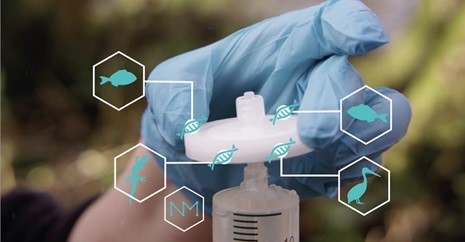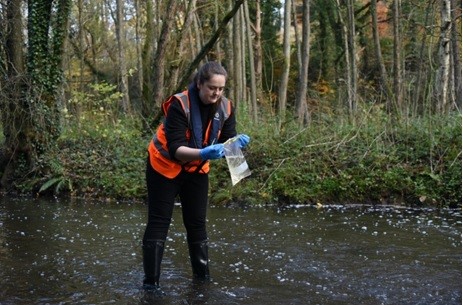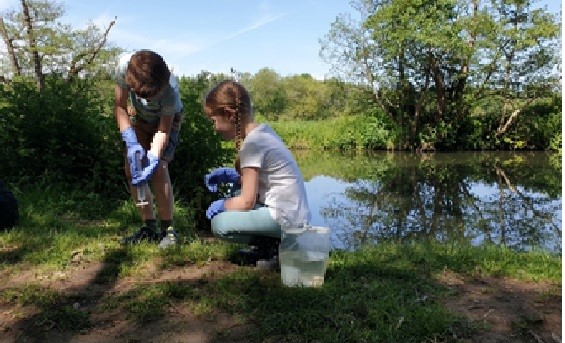Written by Dr Katie Cruickshanks & Molly Czachur, NatureMetrics
Strengthening our understanding of UK biodiversity is a priority for effective management, yet we have an urgent need for better data. NatureMetrics scientists have developed scalable DNA based monitoring technologies that complement our existing biodiversity dataflows, giving rise to a new data layer for biodiversity generated using DNA species leave behind in their environment.
As we find ourselves in the midst of a mass extinction, there is an ever-growing urgency for improving species records to better understand where key species are living. At NatureMetrics we believe: ‘that which is measured improves’, and we are using DNA technologies to scale up the measurement of nature over space and time.
Rather than monitoring a handful of species, such as European Protected Species, DNA gives us the power to collect more datapoints from many more species to better understand the natural world. There’s been a bottleneck when it comes to turning nature into data, and until now we’ve had to examine each organism individually to identify them, and it’s just not possible to generate big data in this way. This is not the end of traditional recording as we know it – we need to be naturalists too – but it’s time to work together to add another string to our bow in the evolution of UK biodiversity data flows.
In 2014, a group of scientists wanted to connect environmental managers with the latest DNA solutions for biodiversity, and thus NatureMetrics was born. Now, our team of ecologists, molecular biologists, conservationists and data scientists are changing the biodiversity data landscape. We’ve swapped the traps and the microscopes for DNA sequencing which lets us identify thousands of species at once. Our “eDNA from water” technologies allow anybody to test the biodiversity of a water body, whether it be a lake, river, stream or ocean, by collecting and filtering a water sample and sending it to the NatureMetrics labs for analysis. The results show which species’ DNA was present in the water, and your water sample is transformed into a list of species which the DNA traces belonged to. From a single sample many different taxonomic groups can be surveyed – from fish and birds to amphibians, bacteria and invertebrates.

These environmental DNA technologies are changing the way we monitor the natural world and are generating large datasets that help us to understand species distributions globally. The NatureMetrics scientists recover millions of DNA sequences every week and have worked with over ten thousand DNA samples. We are seeing the uptake of DNA-based biodiversity surveys growing by the week.

Across a wide variety of UK conservation groups, statutory agencies, rivers trusts, utility companies and citizen science projects, we are compiling a growing database of species records from water, soil, faeces and bulk invertebrate samples. Since the beginning, we have worked with eight UK Wildlife Trusts, thirteen Rivers Trusts and a broad range of NGOs and conservation partnerships. Our work with NGOs, trusts and community groups generates some of the most rewarding and interesting data. In a recent study with The National Trust, we developed a citizen science project to better understand the biodiversity supported by a handful of their numerous ornamental lakes. From 40 samples, 74 unique taxa were identified including 15 fish, 4 amphibians, 33 birds and 22 mammals, and you can explore more of this data in our recent NatureMetrics webinar. The ability to generate impressive datasets in this way is efficient, accurate and engaging for all stakeholders. We are regularly working with site managers to better characterise their sites alongside conventional survey data. This side-by-side approach enhances evaluation of land management decisions and supports the measurement of conservation outcomes and impact.
When we develop our DNA technologies, it is essential that they are easy to use. Recently, the Project Chairman of a local action group “River Action” carried out eDNA surveys of aquatic macroinvertebrates in three Hampshire chalk streams despite having no prior ecological experience, generating important data to inform their campaigns. Also, in a head-to-head experiment between a group of children and our founder and eDNA expert Dr Kat Bruce, both children and experts were able to collect almost identical biodiversity data using “eDNA from water”- highlighting the power and ease of these DNA technologies for acquiring data.

One of the huge benefits of DNA-based monitoring is the ease with which anyone can gather data. This democratisation of biodiversity data can efficiently get the information into the hands of those that need it. The simplicity means that large scale data gathering projects can be delivered with citizen scientists proactively contributing to major national and international conservation research programmes. A recent example of this is the 1,000 Rivers Project which aims to characterise the fish diversity of one thousand rivers across the Atlantic, with river sampling in the South of England being coordinated by NatureMetrics alongside a range of other partners including the University of Hull. Citizen scientists from the 1,000 Rivers project have been collecting water samples from rivers across the British Isles, Continental Europe and Canada. The citizen science water samples are analysed by eDNA laboratories to reveal the fish communities present in the rivers, and the data forms the basis of a long-term fish monitoring programme.
It is an incredibly exciting time to be working in the world of biodiversity data. From government pledges on biodiversity net gain to landscape-scale conservation projects and local action groups, there has never been a better time to integrate the best tools to generate evidence and support decision making. We are committed to unlocking data at scale to help conserve species and habitats and halt the biodiversity crisis – but we can’t do this alone. Partnerships working across Local Environmental Records Centres, NGOs, recording schemes and ecological consultants through the NBN are a great way to accelerate our collective progress on biodiversity data. Together we can build a positive and accessible set of tools and solutions to inform the next phase of large-scale biodiversity monitoring using DNA. Let’s come together to add a new DNA data layer to our understanding of the natural world.
To continue the conversation or begin a new partnership with NatureMetrics, drop us a line at edna-lab@naturemetrics.co.uk. You can also learn more about the DNA technologies discussed here on the NatureMetrics website.
